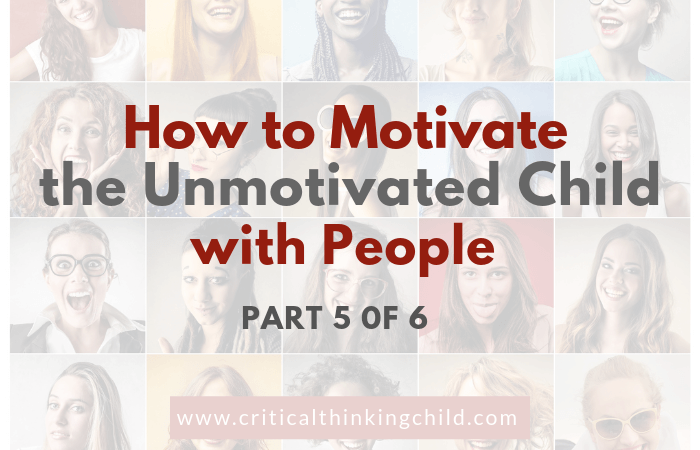Grappling with an umotivated child can be frustrating. That’s why we’ve been diving into six different strategies you can use to encourage your child to take action – even when they’re faced with activities they don’t enjoy. So far, we’ve looked at praise, projects, prestige, and prizes. Today, the topic is People. You’ll learn why people can be effective motivators, what it means to be motivated by people, and how to leverage this motivator with your child.
Just like our previous motivators, this strategy isn’t just for kids. People serve as inspiring catalysts for action at all levels. Think about, for example, a workout partner. It’s harder to skip your trip to the gym if you know someone else is expecting you. We also use people as a reward. For example, we might think, “If I get all my housework done, I can spend time with my friends tonight.” This same thinking can apply to your child.
Who is motivated by people?
Relationship-oriented children tend to find motivation in the people around them. Sometimes these are more extroverted and community-driven children, but not always. They are children who value the relationships around them, whether it’s with a large group of friends, a sibling, or a few select best friends.
If you’re considering using people as a motivator, pay attention to how your child reacts naturally around different people. If your child is shy and prefers to keep to themselves, offering time with others may actually cause more harm than good and decrease your child’s motivation.
People are great motivators for more social children who are energized by spending time with others and work well in a group setting with other children. Often, these same children also value relationships with important adults, like parents and teachers. These relationships can also be leveraged into motivators.
Why do people work as motivators?
People are effective motivators for a variety of reasons: they can serve as accountability partners, they make work seem easier or more fun, they sometimes raise expectations and offer praise when they are met, and they can provide a reward for finishing work or celebrating accomplishments.
Even young children often rely on peers as accountability partners. For example, in kindergarten or first grade students may work on group tasks, such as buddy reading. More social students won’t want to let their team down. Similarly, students who might be reluctant readers on their own may thrive when reading with a partner because they get to interact and share a book together.
Adults can serve as motivators by setting high (but reasonable) expectations for children. Continuing with reading, a teacher might ask students to read for twenty minutes when the child typically only reads for ten. Children with strong relationships with their teachers are more likely to want to complete this goal so they can please the teacher.
People can also work as “prizes” after a goal is met. If your child has been talking back, instigating fights, or acting otherwise out of line, you may offer a reward if they refrain from the negative behavior. For example, if your child goes a week without raising their voice, they may be able to spend time with a friend or have lunch out with an adult they look up to. Just a few extra minutes with a person your child values is often a huge motivator.
How do I use people to motivate my child?
When preparing to leverage people to motivate your child, you don’t need to spend time guessing. Ask your child about their favorite activities and who they most enjoy doing these activities with, both at home and at school. Ask about favorite teachers, family members, neighbors, and classmates and keep a running list of the people who are most important to your child.
After that, come up with two plans: a proactive plan and a reactive plan. For the proactive plan, use people to help your child complete tasks. Perhaps your child is more eager to do math homework when his older sister is there with him; see if you can make that happen. If your child is more interested in reading at school if their teacher providing additional support, see if that’s possible, even for a few minutes. Having people present during challenging tasks can prevent unmotivated and challenging behavior from even happening in the first place.
Your second plan is a reactive, or a reward plan. This is for when your child completes a task or accomplishes something special. These rewards can be simple or elaborate. They can be as basic as five minutes of extra play time with a good friend, lunch with a special teacher, or game time with you. If you want to reward a particularly amazing accomplishment, you can go as far as a full activity: a day at the water park with a friend, a trip to the zoo with Grandma, or a movie night with siblings. Knowing that people will be proud of them at the end of a challenging road will serve as an extra motivator for those social and people-driven children.
People motivate other people
It’s no surprise that the people around us serve as some of our greatest motivators. We’re constantly seeking out community, looking for recognition, and developing friendships. When you’re working with your child and he or she seems less motivated than usual, these relation



